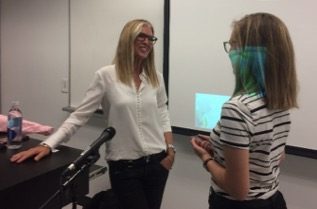Former Toronto CityNews journalist Avery Haines was embedded in West Mosul, Iraq in 2017 where people were trapped in what she later described in a Maclean’s article as, “a hellish limbo between a death-like life and death itself.” But when, Haines, who now works for CTV News’ W5 team, returned to Toronto ready to report about life under the Islamic State militants, she discovered that her Toronto viewers and producers were more interested in her own story overseas than in the ordeal of the victims of ISIS.
“This whole focus on ‘Did I feel safe?’ Well, there are hundreds of thousands of people who are legitimately not safe,” Haines told journalism students at Centennial College’s Story Arts Centre campus in East York, on Oct. 3, 2017. “I have ten men with AK-47s protecting me and there are families two kilometres away whose kids are getting slaughtered.”
Haines spent her time in Mosul with the NGO Global Response Management. She was volunteering at a former ISIS mosque turned into an American-run medical clinic a few kilometres away from the front lines, where approximately 200,000 civilians were held hostage. When she was not comforting those who were being treated by volunteer doctors, including Haines’ wife Dr. Mel Brecknell, Haines was filming. Haines returned to Canada with nine hours of footage, enough to make her hour-long documentary called, “Two Kilometres to Terror: Life and Death under ISIS”, which aired on July 9 ─ the same day Mosul was liberated from ISIS.
The terrorist organization seized control of Iraq’s second largest city, Mosul, in June 2014. Iraqi forces battled against ISIS for more than eight months, resulting in over 40,000 civilian deaths. For her documentary, Haines had the chance to interview Iraqi civilians who were most vulnerable to ISIS attacks.
“I’ve always been really honoured by the power that I have in my profession to amplify someone else’s voice,” Haines said.
In Mosul, Haines was constantly lending an ear and listening to the many people who she feels craved sympathy.
“Sympathy is dried up there,” Haines said. “No one is crying for anyone else.”
She met people who would introduce themselves by sharing their name, immediately followed by the number of people in their family who were killed by ISIS. As she listened to their horrific stories, which she later shared in her documentary and other reporting, Haines became the bridge between two worlds.
Back in her home country, people were captivated by the idea of a fellow Canadian who has never seen violence, suddenly finding herself in a place where the landscape’s soundtrack is composed of airstrikes and guns.
However, as Canadian media pushed to focus on Haines’ personal experience, she worked hard to put the spotlight on the people of Mosul, the ones who have suffered the most.
“It’s human nature to be interested and drawn into something that we can relate to,” Haines said. “It’s the worst part of human nature, I think.”

